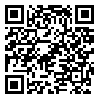Thu, Jan 1, 2026
Volume 10, Issue 4 (Autumn 2024)
Caspian J Neurol Sci 2024, 10(4): 347-353 |
Back to browse issues page
Download citation:
BibTeX | RIS | EndNote | Medlars | ProCite | Reference Manager | RefWorks
Send citation to:



BibTeX | RIS | EndNote | Medlars | ProCite | Reference Manager | RefWorks
Send citation to:
Rimaz S, Emir Alavi C, Soltanipour S, Sedighinejad A, Einollahzadeh R, Haghighi M, et al . Efficacy and Safety of Cisatracurium in Electroconvulsive Therapy: A Randomized, Single-blind, Clinical Trial. Caspian J Neurol Sci 2024; 10 (4) :347-353
URL: http://cjns.gums.ac.ir/article-1-730-en.html
URL: http://cjns.gums.ac.ir/article-1-730-en.html
Siamak Rimaz1 

 , Cyrus Emir Alavi2
, Cyrus Emir Alavi2 

 , Soheil Soltanipour3
, Soheil Soltanipour3 

 , Abbas Sedighinejad1
, Abbas Sedighinejad1 

 , Reihaneh Einollahzadeh1
, Reihaneh Einollahzadeh1 

 , Mohammad Haghighi1
, Mohammad Haghighi1 

 , Ali Pourramzani *4
, Ali Pourramzani *4 

 , Gelareh Biazar1
, Gelareh Biazar1 




 , Cyrus Emir Alavi2
, Cyrus Emir Alavi2 

 , Soheil Soltanipour3
, Soheil Soltanipour3 

 , Abbas Sedighinejad1
, Abbas Sedighinejad1 

 , Reihaneh Einollahzadeh1
, Reihaneh Einollahzadeh1 

 , Mohammad Haghighi1
, Mohammad Haghighi1 

 , Ali Pourramzani *4
, Ali Pourramzani *4 

 , Gelareh Biazar1
, Gelareh Biazar1 


1- Department of Anesthesiology, Anesthesiology Research Center, Faculty of Medicine, Alzahra Hospital, Guilan University of Medical Sciences, Rasht, Iran.
2- Department of Anesthesiology, Neuroscience Research Center, Faculty of Medicine, Guilan University of Medical Sciences, Rasht, Iran.
3- Department of Community Medicine, Faculty of Medicine, Guilan University of Medical Sciences, Rasht, Iran.
4- Department of Psychiatry, Kavosh Cognitive Behavior Sciences and Addiction Research Center, Faculty of Medicine, Guilan University of Medical Sciences, Rasht, Iran. ,dr_pourramzani@yahoo.com
2- Department of Anesthesiology, Neuroscience Research Center, Faculty of Medicine, Guilan University of Medical Sciences, Rasht, Iran.
3- Department of Community Medicine, Faculty of Medicine, Guilan University of Medical Sciences, Rasht, Iran.
4- Department of Psychiatry, Kavosh Cognitive Behavior Sciences and Addiction Research Center, Faculty of Medicine, Guilan University of Medical Sciences, Rasht, Iran. ,
Abstract: (955 Views)
Background: Electroconvulsive therapy (ECT) is widely accepted as a safe and effective treatment in psychiatric patients. Although succinylcholine is the choice of muscle relaxant in this process, its adverse effects and contraindications must be considered.
Objectives: This study investigated the efficacy of cisatracurium as an alternative in ECT patients.
Materials & Methods: This single-blind clinical trial was performed in an academic hospital in Northern Iran from July 2023 to March 2024. A total of 62 eligible ECT patients were enrolled in the survey and randomly divided into succinylcholine (0.5 mg/kg) and cisatracurium (0.1 mg/kg) groups. Seizure duration, mean arterial pressure, heart rate, the time to return to spontaneous breathing, and recovery time were recorded and compared between the two groups.
Results: No significant difference was observed between the two groups regarding seizure duration and hemodynamic parameters (P>0.05). However, the time to return to spontaneous breathing (P=0.0001) and recovery time (P=0.0001) were significantly longer in the cisatracurium group. None of the patients was affected by serious adverse effects.
Conclusion: Cisatracurium is a safe alternative to succinylcholine and can be administrated during ECT.
Objectives: This study investigated the efficacy of cisatracurium as an alternative in ECT patients.
Materials & Methods: This single-blind clinical trial was performed in an academic hospital in Northern Iran from July 2023 to March 2024. A total of 62 eligible ECT patients were enrolled in the survey and randomly divided into succinylcholine (0.5 mg/kg) and cisatracurium (0.1 mg/kg) groups. Seizure duration, mean arterial pressure, heart rate, the time to return to spontaneous breathing, and recovery time were recorded and compared between the two groups.
Results: No significant difference was observed between the two groups regarding seizure duration and hemodynamic parameters (P>0.05). However, the time to return to spontaneous breathing (P=0.0001) and recovery time (P=0.0001) were significantly longer in the cisatracurium group. None of the patients was affected by serious adverse effects.
Conclusion: Cisatracurium is a safe alternative to succinylcholine and can be administrated during ECT.
Type of Study: Research |
Subject:
Special
Received: 2024/07/13 | Accepted: 2024/07/24 | Published: 2024/10/5
Received: 2024/07/13 | Accepted: 2024/07/24 | Published: 2024/10/5
Send email to the article author
| Rights and permissions | |
 | This work is licensed under a Creative Commons Attribution-NonCommercial 4.0 International License. |



